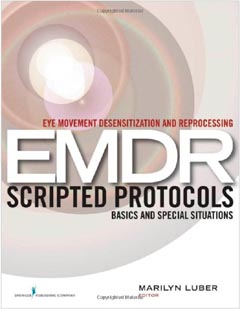
Eye Movement Desensitization and Reprocessing (EMDR) Scripted Protocols
The effects of trauma are felt across a wide range of circumstances, from natural and man-made events to many more commonly experienced situations. Many of these experiences can result in the formation of dissociative disorders and other disabling psychological conditions when they are not addressed with early intervention and counseling. A promising therapy pioneered by Francine Shapiro currently being applied to resolve conditions associated with trauma-related disorders is known as Eye Movement Desensitization and Reprocessing (EMDR).

Dr. Marilyn Luber PhD is a leading psychotherapist practicing in the field of EMDR therapy, applying its integral approach for patients of her general private practice in Philadelphia. She has published numerous academic articles on the subject, together with the Handbook for EMDR Clients which has been translated into eight languages. Dr. Luber has also edited two definitive texts on the subject of EMDR including: Eye Movement Desensitization and Reprocessing (EMDR) Scripted Protocols: Basics and Special Situations and Eye Movement Desensitization and Reprocessing (EMDR) Scripted Protocols: Special Populations.
These two texts provide practicing psychotherapists with the tools needed to apply EMDR techniques across a complete range of conditions where this type of therapy has proven to be effective. Both books provide comprehensive scripted protocols as a valuable resource for therapists to follow throughout the treatment process, and discuss strategies that can be applied for patients suffering from a wide range of identifiable conditions, including: traumatic events, anxiety, addictive behaviors, phobias, dissociative disorders, excessive grief, and illness and somatic disorders. The Special Populations edition extends this scope to include EMDR for: couples therapy, informed treatment approaches for dissociative disorders, clearing the pain of unrequited love, treating substance abuse and addiction, severe pain, and self-care for EMDR practitioners.
EMDR involves a structured, phased approach to resolve those elements of traumatic or distressing memories that have resulted in a dysfunctional aggregation within an individual's psychological make up. As therapy, EMDR addresses the past, present, and future aspects of traumatic memories through a combination of recognized therapeutic methods that involve: effective psychodynamic, imaginal exposure, cognitive therapy, interpersonal, experiential, physiological and somatic methodologies. The distinguishing feature of EMDR is the concomitant application of bilateral stimulation, using eye movement, tones, or tapping, while the patient is in the process of recollecting and reprocessing the traumas which have been identified as the cause of the disorder.
As a member of the Founding Board of Directors of the EMDR International Association (EMDRIA) and while serving as the Chairman of the International Committee, Marilyn Luber developed a valuable perspective that has enabled her to advocate for EMDR among her colleagues while also conducting training programs for Facilitator and Supervisory clinicians, together with other EMDR-related topics, both nationally and internationally. Her general practice works regularly with adolescents, adults, and couples to apply EMDR therapies for resolving complex post-traumatic stress disorder, trauma and related issues, and dissociative disorders.




